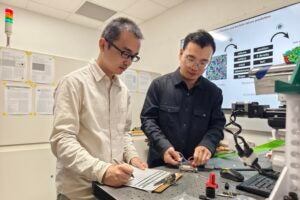In one of the nation’s largest-scale initiatives to incorporate new technologies into the delivery of large enrollment lower-division courses, The University of Texas at Austin will add five courses to its Course Transformation Program.
The additions in history, calculus, statistics, government and classics will bring to 14 the number of large, lower-division gateway courses that have been redesigned as part of this $3 million effort to improve student learning and advance educational excellence. Previous redesign projects have included entry-level courses in biology, chemistry, statistics, English, economics and psychology. Together, these courses have an overall annual enrollment of more than 20,000, meaning that the majority of UT Austin undergraduates will soon have the opportunity to take lower-division courses that combine advanced learning technologies with world-class faculty instruction.
As courses are successfully transformed, the university plans to award three-year, $50,000 grants to each department to support implementation of the redesigned course materials. The first grants will be awarded in fall 2013 to biology, chemistry and statistics. Departments will use these funds to support ongoing innovation around these courses, including the development of additional online content. The courses are an integral part of the university’s overall strategy for technology enhanced education, which is designed to support faculty experimentation and innovation with online learning models to promote student success and improve the undergraduate experience.
“In the past three years, we’ve seen our freshman persistence rates climb,” said David Laude, senior vice provost for enrollment and graduation management. “There is a direct correlation between these transformed courses and freshman year success courses that had nonpassing rates of up to 30 percent a year ago have cut that by more than half.”
The University of Texas at Austin initiative, which is in its third year, is a central element in President Bill Powers’ campaign to reinvent higher education for the 21st century. All the transformed courses developed to date have a hybrid structure that combines advanced educational technologies and best practices in teaching, including robust in-class discussion, video modules to supplement readings, team-based learning models and immediate student feedback.
The results have been striking: Transformed versions of courses have yielded higher grades, improved attendance and lower QDF rates (students who drop a class or receive a letter grade of D or F). Students are also showing improved performance in subsequent classes.
“These new courses represent an important expansion of this effort that will touch nearly every undergraduate at UT Austin,” said Gretchen Ritter, vice provost for undergraduate education and faculty governance and director of the Course Transformation Program. “Our goal is to make these courses sustainable, giving students the access to the advantages of educational technology, customized learning experiences and faculty interaction.”



